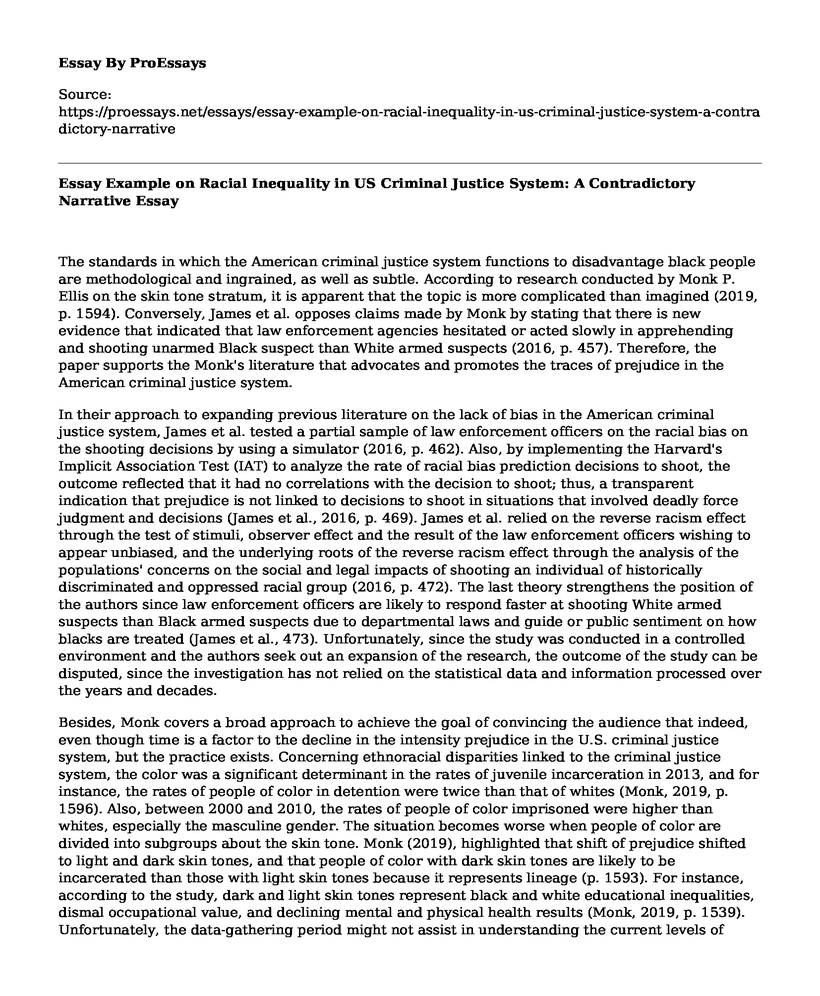The standards in which the American criminal justice system functions to disadvantage black people are methodological and ingrained, as well as subtle. According to research conducted by Monk P. Ellis on the skin tone stratum, it is apparent that the topic is more complicated than imagined (2019, p. 1594). Conversely, James et al. opposes claims made by Monk by stating that there is new evidence that indicated that law enforcement agencies hesitated or acted slowly in apprehending and shooting unarmed Black suspect than White armed suspects (2016, p. 457). Therefore, the paper supports the Monk's literature that advocates and promotes the traces of prejudice in the American criminal justice system.
In their approach to expanding previous literature on the lack of bias in the American criminal justice system, James et al. tested a partial sample of law enforcement officers on the racial bias on the shooting decisions by using a simulator (2016, p. 462). Also, by implementing the Harvard's Implicit Association Test (IAT) to analyze the rate of racial bias prediction decisions to shoot, the outcome reflected that it had no correlations with the decision to shoot; thus, a transparent indication that prejudice is not linked to decisions to shoot in situations that involved deadly force judgment and decisions (James et al., 2016, p. 469). James et al. relied on the reverse racism effect through the test of stimuli, observer effect and the result of the law enforcement officers wishing to appear unbiased, and the underlying roots of the reverse racism effect through the analysis of the populations' concerns on the social and legal impacts of shooting an individual of historically discriminated and oppressed racial group (2016, p. 472). The last theory strengthens the position of the authors since law enforcement officers are likely to respond faster at shooting White armed suspects than Black armed suspects due to departmental laws and guide or public sentiment on how blacks are treated (James et al., 473). Unfortunately, since the study was conducted in a controlled environment and the authors seek out an expansion of the research, the outcome of the study can be disputed, since the investigation has not relied on the statistical data and information processed over the years and decades.
Besides, Monk covers a broad approach to achieve the goal of convincing the audience that indeed, even though time is a factor to the decline in the intensity prejudice in the U.S. criminal justice system, but the practice exists. Concerning ethnoracial disparities linked to the criminal justice system, the color was a significant determinant in the rates of juvenile incarceration in 2013, and for instance, the rates of people of color in detention were twice than that of whites (Monk, 2019, p. 1596). Also, between 2000 and 2010, the rates of people of color imprisoned were higher than whites, especially the masculine gender. The situation becomes worse when people of color are divided into subgroups about the skin tone. Monk (2019), highlighted that shift of prejudice shifted to light and dark skin tones, and that people of color with dark skin tones are likely to be incarcerated than those with light skin tones because it represents lineage (p. 1593). For instance, according to the study, dark and light skin tones represent black and white educational inequalities, dismal occupational value, and declining mental and physical health results (Monk, 2019, p. 1539). Unfortunately, the data-gathering period might not assist in understanding the current levels of prejudice practice in the American criminal justice system; the study analyzes the impact of the Civil Rights legislation as well as its influence on color discrimination. The study enhances an array of control measures that need to be implemented to combat and manage the issue of prejudice within the criminal justice system, for example, researchers need to focus beyond black and white when recommending mitigation approaches for ethnoracial disparities.
Conclusion
To conclude, there is no doubt that the American criminal justice system practices prejudice due to two reasons. First, even though James et al.'s research does not agree with the stand, controlled studies are but a reflection on a projected outcome, and often when implemented in the real world, the results might differ. Next, Monk introduced the norms of skin tone as well as statistical analysis on incarcerations. The data was gathered from reliable sources, and the analysis indicated that the criminal justice system practices prejudice. Finally, statistical analysis surpasses theoretical explanations in terms of accuracy, reliability, value, and interpretation.
Cite this page
Essay Example on Racial Inequality in US Criminal Justice System: A Contradictory Narrative. (2023, Mar 26). Retrieved from https://proessays.net/essays/essay-example-on-racial-inequality-in-us-criminal-justice-system-a-contradictory-narrative
If you are the original author of this essay and no longer wish to have it published on the ProEssays website, please click below to request its removal:
- Women in the Justice System
- Paper Example on Sentencing with Diverse Population Groups
- Essay on Feminist Views
- Empathy, Narrative, and Victim Impact Statements Paper Example
- Range of Criminological Theories and Quantity of Homicides Incidents Paper Example
- Essay Sample on White Collar Crime
- Essay Sample on The Harm Principle: Limiting Liberty to Protect Others







